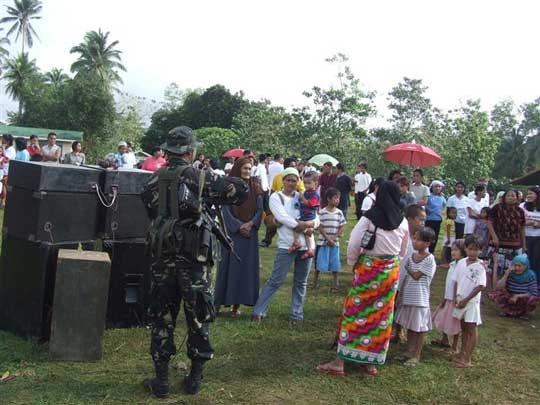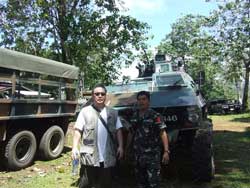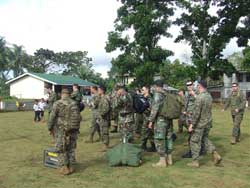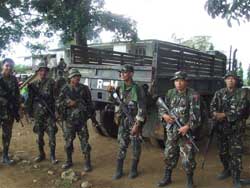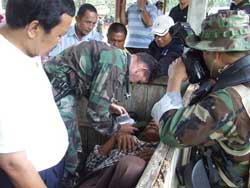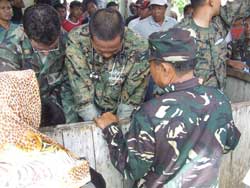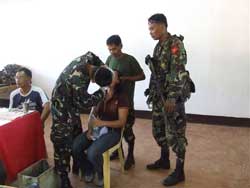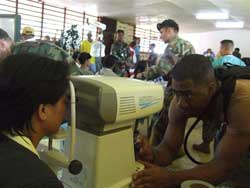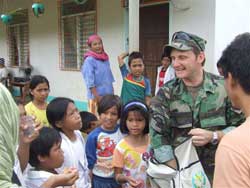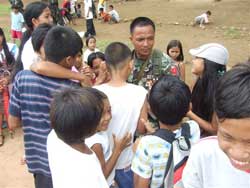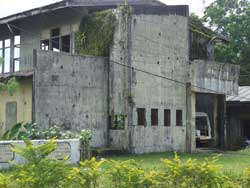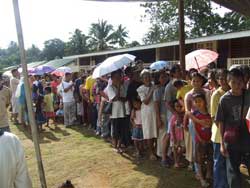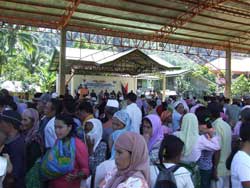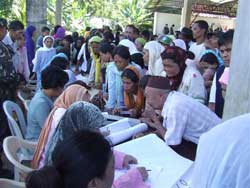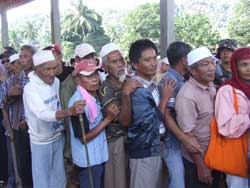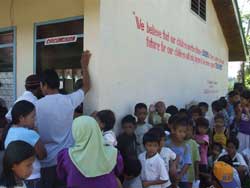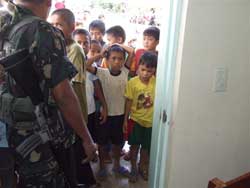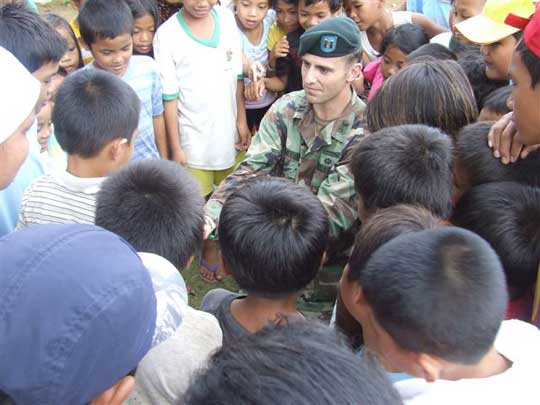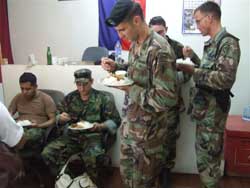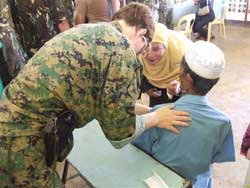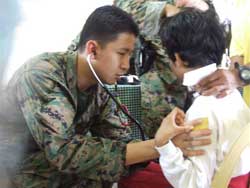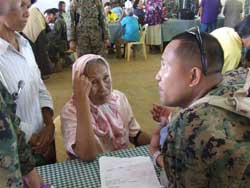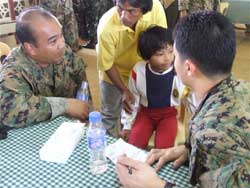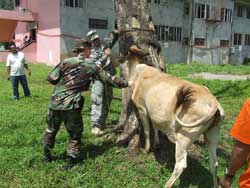Joint United States and Philippine Military Medical Mission Eyewitness Report.
Written by
Gaku Homma
Nippon Kan Kancho
April 6th, 2007
A few years ago there were two popular Japanese movies being shown in theaters in the United States. I am not a movie critic, so I can’t tell you which one was better, but from my point of view as a Japanese martial artist there were very important and distinct differences. One of the feature films was “The Last Samurai” starring Tom Cruise. The other movie was called the “Twilight Samurai”, and featured Hiroyuki Sanada.
The Last Samurai was a movie about Japan, and had many Japanese actors playing in it but it was definitely a movie made in the USA for American audiences. The most blatant example of this is during the “climax” scene when the samurai were being slaughtered by the Japanese military with Western made gattling guns. This was an embellishment of true Japanese history that would not have been portrayed by a Japanese author. This scene as it was portrayed was a dramatic, emotional reenactment of something akin to the slaughter of American Indians by the U.S. Calvary at Wounded Knee. Although gut wrenching, this scene was actually a great misrepresentation of true samurai spirit. There have been other misrepresentations of samurai spirit that have caused great damage not only in the movies but in our real-life world history; the Japanese kamikazebombings towards the end of WWII is one good example.
“The Twilight Samurai” is a movie about a lower ranked common samurai ordered by his lord to kill someone. He did not want to do this, but of course as a samurai, low rank or not, he was obligated to obey. This movie did not have the budget of “The Last Samurai” and it is a much more simply portrayal of the life of the samurai in Japan. It is however a much closer representation of true samurai spirit. I was especially moved by a scene toward the end of the movie when the modest samurai returned from his mission. He returns home with his clothes in tatters and bleeding from superficial wounds to the arms of his waiting daughter who greets him with a desperate hug. It is touching scene. This is a closer representation of the real samurai in Japan.
I have been asked on numerous occasions while teaching Aikido, what the difference is between Aikido and other full-contact, competitive sport martial arts. Sometimes I use the comparison of these two movies as my answer. “The Last Samurai” is more representative to me of the full- contact, competitive, sport martial arts while “The Twilight Samurai” is more representative of Aikido.
******************
The true mission of the samurai is to say “Ittekimas” (I am leaving now) when leaving home to do battle, and to say “Tadaima” (I am home) after he returns. This sounds so simple, but there is deep meaning in this phrase. A student once commented after pondering this statement, “If the samurai were to lose in battle, then he won’t be coming home”. I replied “For the samurai, it is not only the winner of a battle that returns home. Both the winner and the loser must return home. This is the true mission of the samurai and a basis of true samurai philosophy.
In movies about the Japanese samurai, there is always some kind of climactic fighting scene with lot of swords being brandished about. These exciting scenes liberally embellish the actual history being portrayed, but the exaggerations make the story more eligible to become a box office hit.
I know that there have been battles fought with swords by the samurai, but it is also important to look at all of the events that led up to these scenes of battle in our history. Even news media reports and documentaries in our world today do not tend to focus on the whole picture. They focus on sensationalism to sell their own particular position. The new media does not cover many of the more positive developments or other advancements being made in our world because they are less exciting and “news worthy”. Instead media outlets favor the telling of the more sensational and usually more gruesome stories and developments that boost ratings or distribution.
Historically in Japan, the peak of the samurai’s struggle for ultimate dominance in Japanese rule was from the end of the Kamakura period (1185-1333) through the end of the Edo period (1603-1867). During this roughly six hundred year period, the philosophy of the samurai and concept of samurai spirit changed with the continual developments in Japan’s political, social, economical and religious organization. Especially the introduction of Zen Buddhism to Japan had a great influence on the psychological and spiritual development of samurai philosophy.
There was one particular teaching in Zen Buddhism that caused a tremendous internal conflict for the samurai; that being the sanctity of all life. In Zen Buddhism, an important covenant mandates that no life is to be taken; a concept for the samurai that clashed directly with his primary job description-to kill.
Abiding by this covenant put the samurai who believed in the teaching of Zen Buddhism in a quandary. In a battle, if a samurai were not to kill, he may well forfeit his own life. This concept was a great contradiction in the way of life for the samurai which ultimately stimulated the highest level of development of the samurai spirit.
In general, all warriors from all times in history have had great allegiance to their own countries and a great sense loyalty to their families and to their God. It is the duty of a warrior to sacrifice their own life for their country so in this sense warriors with honor everywhere have much in common. Most warriors are good people who simply rise to the call to defend their families and their homes if threatened by aggression towards them. Honest, innocent men and women will draw a sword with a tear in their eye to protect those they love. This has been part of the human story since the beginning of history, but in the depths of this determination of the good hearted, is the conflict of knowing of the sanctity of life. This underlying contradiction is where bushido or samurai spirit was born.
In many parts of our world today there is conflict. Today’s warriors or soldiers deal with the same philosophical conflict and contradictions as the samurai of the days of old; both have a duty and a mission to fulfill and a regret to do harm to others.
Many young soldiers today return from the front lines of any war with deep physical or psychological scars. Some are emotionally damaged and confused by the inner conflicts over their experiences. Considering the horrors of any war, this is an understandable consequence. Today’s soldiers may have doubts and conflicts to deal with, but still must carry on with their missions just as the samurai did. What held as truth for the samurai still holds true for the warriors of today. The seeds of samurai spirit were to be found in inner conflict, and that inner conflict is the first beginnings of inner peace. Without this inner conflict there can be no growth towards inner peace.
Having this kind of inner conflict while engaged in war can be exasperating for those living through it. There are those however who are building peace out of this conflict. The following eyewitness report is not an effort to try to hide the dreadfulness of war behind flowery words, but there are many of today’s soldiers that are working very hard to recover and transform these scars of destruction. These are the soldiers that I wish to speak about. My opinion of their operation is from a Japanese martial artist’s point of view. It may be a different perspective, so I ask for your patience as you read forward.
I had the distinct honor this past February to be able to join a joint United States Army and Philippine Army medical mission deep into the jungles of Mindanao. Usually stories of war speak of the violence of the front lines, but this experience was one of peace in a zone of war. What were these soldiers doing on this mission? It became my understanding that they were trying to give meaning to the sacrifices that had been made in the name of many wars. The ultimate success or failure of this mission I think was very important in addressing that inner conflict of all the soldiers and their families back home. This was a very important mission, and these soldiers held a very important key.
We were headed for two villages in the jungles in the southeast part of Mindanao. The area had a dark history of religious and political strife, and independent resistance groups such as the MNLF and the NPA, and Southeast Asian terrorist groups such as Abu Sayyaf and Jemaiah Islamiah are very active here. The United States Army and the Philippine Army together had calmed much of the activity in the region, so currently in this area a tentative cease-fire was in place.
We were accompanied on this mission by over 100 Philippine soldiers which indicated to me that the cease fire might not be as stable as one would have hoped. We arrived at the first village at about 9:00 am after a three hour drive over difficult terrain. Even some of our army four wheel drive vehicles kept high centering on the bumpy uneven roads.
The second day of this mission in the jungles of Mindanao is where I will begin this story.
With our Philippine army escort in full combat gear, we had entered the village square. Slowly and quietly at first the villagers began coming forward. It took only moments before there were close to 1000 people formed into a line to register for the medical treatment we had come to offer. In the line was a very frail elderly man being physically supported on his feet by his wife and daughter. We did not know at that time how serious this man’s condition was or that his ability to wait was nearing an end. Soon it became apparent that the line was going to be too taxing for him and the elderly man was laid down on a small bench in front of the village mosque. With 1000 people clamoring for medical attention, this elderly gentleman’s plight soon fell out of sight.
Using the village school as a temporary medical facility, each classroom was designated for different procedures. There were rooms for internal examinations, minor surgery, eye care and dental care. That day over two hundred boys were also circumcised. Each room was packed with people that came in waves, sometimes you could not see the doors to the classrooms there were so many people waiting for attention.
In the middle of all of this, one of the U.S. military doctors took a moment to attend to the elderly man waiting on the bench. With the available equipment, the man was given a thorough examination and the doctors found a problem with his heart that they thought could be treated if he was moved to a larger facility in a neighboring town. The elderly gentleman refused to leave his family and his village however so he was treated with what was available here at our make shift triage center.
- Doctors asking the elderly man too go to neighboring town hospital.
- Doctors administer CPR.
Around the elderly man and his attending doctors, the villagers fell into silence. Everyone’s attention was focused on the feverish efforts of the doctors as they worked to stabilize the elderly man. They continued their efforts for about 30 minutes…and then they stopped. Slowly the chief military doctor raised his head and took a step backward in respect. He made the sign of the cross, announcing without words the death of the elderly man. Everyone understood the meaning of his gestures. The other doctors stood together in a short prayer over the man, a look of sadness on their faces.
All of a sudden I became very alert, and a little worried. The people that had gathered in this village square were from different villages and from different factions. There was a cease fire in place in this area, but we were strangers in their village and the trust that we had built was yet a fragile one. I worried about what the villager’s reaction would be to the elderly man’ death. From the silence, the wife of the deceased man began to speak to us through an interpreter. “My husband was a lucky man. He died here in front of our village mosque with all of these doctors here to care for him and surrounded by his family to witness his departure. It was a blessing from God”. After she spoke everyone was quite but there was no sign of any bad will. The family quietly loaded the elderly man’s body into a car to make his final journey home.
- Working with limited medical equipment.
- All of their doctors giving their best efforts.
Before I had witnessed with my own eyes how this joint military team treated all of the villagers and especially how desperately they tried to care for the elderly gentleman, I thought that this mission was going to be mostly conciliatory in nature. It was nothing of the sort. The foundation for the mission was simple and pure; people who can — helping people who can’t. It was this simple foundation that made this mission a success. For those on this mission, it was also a great responsibility, for in the success of this mission lay the hope of restoration and rebirth in this land from the psychological and physical damages of war. It was the purpose and the responsibility of this mission that left the team resolved and with out fear.
The military doctors were kind and gentle with each patient they treated, and they worked tirelessly without breaks. The spent a great deal of time teaching the doctors in the Philippine army with the hopes that they would be able to continue with this mission of peace for a long time to come.
- On Site dentistry.
- Eye examinations.
The woman motioned me into the kitchen as the others settled down at this cornucopian feast. “Do you think there is enough food?” she asked sincerely. “We are just a small village, so I do not have much to offer except for sea foods, which we have plenty of… ” I assured her that there was plenty of food and that she had outdone her self. Her grandchildren scurried about stealing glimpses at the Americans as they carried platters of food to and fro.
As we sat down to dinner, Dr. Williams, a physician who was part of the tour reached out and kindly touched the woman’s hand which was gnarled and wrinkled from age and a life time of hard work. He spoke to her through an interpreter, “I think you have worked very hard since you were very young” he said kindly. The woman withdrew her hand quickly in surprise and said, “Since I was young I have worked shelling oysters and other chores of the sea”. She seemed to grow more animated and confident speaking these words and spoke up again “I have been to China” she began. “I want to know why Japan started a war with China. Of course we would lose, Japan trying to take on a huge country like that!” She said with a laugh. “After the war, the men in our village told us that if the American soldiers were to ever come here that they would rape all of the young women. We were all terrified after hearing this and made plans about what to do if the Americans ever came. We practiced running to the cliffs to hide, and our plan was that if we were ever found, we would jump from the cliffs to our deaths in the ocean.
The Americans finally did come to the village, and as planned all of the young women ran to the cliffs to hide After about two days however we became hungry and came down to hide instead in sheds outside of our houses. We heard the Americans outside and held our breath, expecting the worst. Outside we could hear the sound of laughter instead of screams and cracked open the doors to the sheds to see our little sisters playing in the American soldier’s jeep. We were astonished!. We had always been told that the American and other coalition soldiers were evil animals, and we had been brainwashed into thinking it was true. From my hiding place in the shed I watched my little sisters as they played. They looked so happy, I took the chance and joined them. All of the American soldiers there for the occupation were quite gentle and respectful and I wondered in shock why we had been fighting these nice people. It made me very angry.
Someday I promised myself, I will be able to tell the American people how I felt that day. Now you have arrived and I am finally able to speak my peace. Now I can die in peace” she said quietly with a single tear. She had spoken so long that even the interpreter was having trouble keeping up with her, but everyone in our group listened to every word, and I saw more than one tear in their eyes. Finally, fifty years after the end of the war, the war was finally over for this elderly woman.
- Entertaining the children is universal.
- Breaktime during the mission for U.S. Special Task Force and Philippine soldiers.
Before the reconstruction began in Japan however, 3, 100,000 Japanese soldiers and civilians had lost their lives in the war. The Japanese that survived did not offer any resistance after the war had ended. We understood that we had lost the war. We understood what our position was and everyone appreciated the aid that they received. We understood how to be samurai from the losing side.
For the years to come the Japanese people worked together toward recovery. The Japan of today is the result of these generations’ great efforts at reconstruction and regeneration. Japan had sustained great loss, and many lives were gone but with a lot of hard work, sacrifice and patience by the families that remained, peace and life were restored once again. Most importantly, the memories of the Japanese soldiers that had lost their lives were restored with the healing evident in the nation. The families of the fallen had vindicating the soldier’s efforts and their ultimate sacrifice. This is true samurai spirit, a spirit of wisdom working for life, not death.
**********************
We have all learned from war, whether by external force or internal strife, much about how miserable war is, and how much pain it causes. Sometimes the lessons of war or warfare in our history have not been used to promote peace, but have been twisted and used to promote more war, hatred and all of the painful consequences this entails.
Towards the end of WWII, the Japanese military commanders began to see that Japan would not be able to win this war. Supplies were low, and countless Japanese soldiers had gone to their deaths. Younger and younger Japanese men were being recruited for the war effort; sometimes including teenage boys. In a desperate effort, new Japanese soldiers were recruited, inticed with the visions of the honor of the tokubetsu kogekitai (or as they were known in the U.S.; kamikazeattackers). These tokubetsu kogekitai were sent to the war fronts basically as the world’s first suicide bombers. Furthering this horror, it is a common opinion in Japan that the suicide bombers of today are a sad mutated copy of the tokubetsu kogekitai. The misled concept of honor behind the tokubetsu kogekitai has been used, manipulated and popularized today even as it was by the Japanese Military commanders in WWII that created them.
During WWII as the Japanese military was been pushed closer and closer towards defeat, the Japanese military leaders themselves twisted the concepts of bushido or samurai spirit to brainwash young soldiers into believing that a mission of certain death was a mission of honor and the way of the samurai. They convinced these young soldiers and their families that it was honorable to die in this way to protect one’s country; producing as a last effort towards victory, a generation of martyrs.
This concept is not part of true samurai spirit. It is a grave mistake to make a heroic story out of these destructive and desperate thoughts and actions. I feel sorry for the tokubetsu kogekitai who were brainwashed into believing that suicide missions were the right and honorable thing to do. At the same time I also respect the courage that these young men had. It was a travesty for the military leaders of Japan to twist the true meaning of bushido into a deformed concept that suited their own means; means that ultimately did not lead to a successful end.
The first job of the samurai was to stay alive; to live to take care of their families and to help build their country into a prosperous and peaceful place for everyone to live. Even if a samurai were to lose his life in battle, or if he chose an honorable death over surrender, it was the duty of the family he left behind to live their lives in a spirit of peace; to work to rebuild, regenerate and replenish what was lost. If the samurai’s family did not live with these goals constantly before them, the life and the death of the samurai went without merit.
There are many facets of Japanese bushido (samurai spirit). The samurai’s sense of honor and allegiance has been twisted and manipulated in recent history to become a misguided model for the terror of the modern suicide bomber. In true bushido, it is important to know intimately where you are standing and to make decisions where you are going from a wide, long term perspective with patience and clarity. Vitally important to the spirit of Japanese bushido is the will and skill to stay alive to be able to care for self and others.
The Japan of today has been rebuilt from the ashes of war. Japan has recovered successfully through the good will and hard work of the people sharing between them a spirit of true bushido and a positive focus on survival.
It saddens me to think that there are those who have a mistaken concept of what bushido is, and even sadder to think there are those that would twist this concept for negative destructive ends. My hope is that there is much good to learn from true samurai spirit; to respect life, country and family. These concepts are part of the Japanese spirit that can serve as a role model for peace anywhere.
***********************
The first day of the mission in the jungles of Mindanao.
To create a less threatening presence, our medical convoy was made up of non-military four wheel drive vehicles. We were however flanked in front and behind by armored military vehicles with about a hundred heavily armed Philippine soldiers on board. The soldiers rode in the accompanying military vehicles keeping their eyes and their guns on the road and countryside as we made our way deeper into the surrounding jungles.
Inside the vehicles, all of the military doctors wore full protective gear and carried firearms at the ready. They wore this protective gear while we were in transit. During our time in the villages however they did not wear this gear, protecting themselves only by carrying pistols concealed under their uniforms. None of the doctors wore bullet proof vests while they were working, and if their had been a sniper attack from afar by rifle or machine gun or hand held mortar, the doctors would have been completely unprotected. There was no way to check amongst all of the people waiting for medical attention for someone carrying a concealed weapon with intent to do harm. When we arrived at the first village there was tension in the air. It did not feel much different to me than what we see in the news reports about activity on the front lines. Without the same resolve as the soldiers on the front lines these military doctors could not have succeeded in this mission.
The young boys line up for circumcisions.
Under a blistering sun they worked without shade or rest as people lined up in a line as far as one could see. Each person in turn was gently examined and asked about the nature of their illness or problems; the doctors making sure they talked to each man, woman and child at their level, so they could speak to them eye to eye. In the two days we were in the villages, about 750 circumcisions were performed. The boys all emerged from the makeshift operating room with proud smiles shouting gleefully to be “a true Muslim now”. Even though there was an underlying tension for the military doctors and accompanying soldiers, they took the time between patients to make the children smile, even playing with the boys when they could find a spare moment
The lunch we were given in the village was simple and served in a very tiny lunch hall. It was so small that most of the soldiers ate while standing. At the end of a very long day, we retired to the camp we had made for a dinner of corn beef, deep fried fish and lots of rice. We ate what the locals ate and I wondered if it would be enough for these strong soldiers. I respected the men for eating the same food as the villagers; it was an important component of the mission we were on.
- Only a moment for a standing lunch.
- A very simple lunch.
“Peace no Saisei” (the rebuilding of peace) is the goal that most honors and respects those who have died. This rebuilding of peace is part of the obligation of those who remain. With the efforts of the living to find peace and rebuild harmony, those that lost their lives can finally return home in memory with a sense of honor, respect and closure.
“Returning Home; the True Mission of the Samurai”, is not only about returning physically. I am referring metaphorically in a broader sense about completing a mission. A samurai might fall in battle, but it is the duty of those around him to carry his mission to the end. It is then, that the samurai can return home. This is the true bushido or samurai spirit.
These medical missions of peace and rebuilding can be accomplished on less of a budget than one high tech missile, and they do no produce causalities or cause destruction. These missions are also welcomed by the people in this area promoting good will instead of fear.
In countries around the world, missions of peace can be accomplished not only medically, but in other ways such as introducing sports and martial arts for the young and the development of farming, ranching and other cottage industries for communities at large. I think that using military troops to establish these programs is a very good idea indeed.
After the mission we returned to our base headquarters and were warmly welcomed by our local support teams there. The soldiers seemed to relax as supplies and equipment were put away and a wave of relief and a sense of accomplishment was in the air. We were served a hearty meal that was quickly consumed by the soldiers before everyone rolled out their bedding, and even without showers, laid down for a deep sleep. The mission was accomplished for today, but there will be many days of rebuilding ahead before the entire mission has been completed; there is a long way to go.
Our world media sources pay little attention to the efforts of the soldiers that are risking their lives to bring peace and restoration in towns and cities not only in the Philippines but around the world. It is part of the obligation of the countries that have prevailed in these conflicts to support these restorative efforts, and it is our obligation to support them.
In this article I have talked about conflict, and military actions, and the military mission I was fortunate to be a part of. The area in the Philippines where these efforts were concentrated was largely a Muslim area. I have been to many other Muslim countries and have many students and friends that are Muslim. Here on this mission in the Philippines and in all of my travels to other Muslim countries I have never experienced any sense of real danger or threat. I have always been treated with the utmost respect and kindness. I was a little worried when I began this article that it might sound like I was taking the side of one particular country or religion. I am not. I am not for war, and I am not a priest. My view of this mission is one of a martial artist.
The purpose of this article has never been to offend any one by talking about sensitive issues. If my limited abilities at writing or editing have offended anyone, please forgive me for it was never my intention.
My hope is that as soon as possible, peace will come to all people and all places, all over the world.


